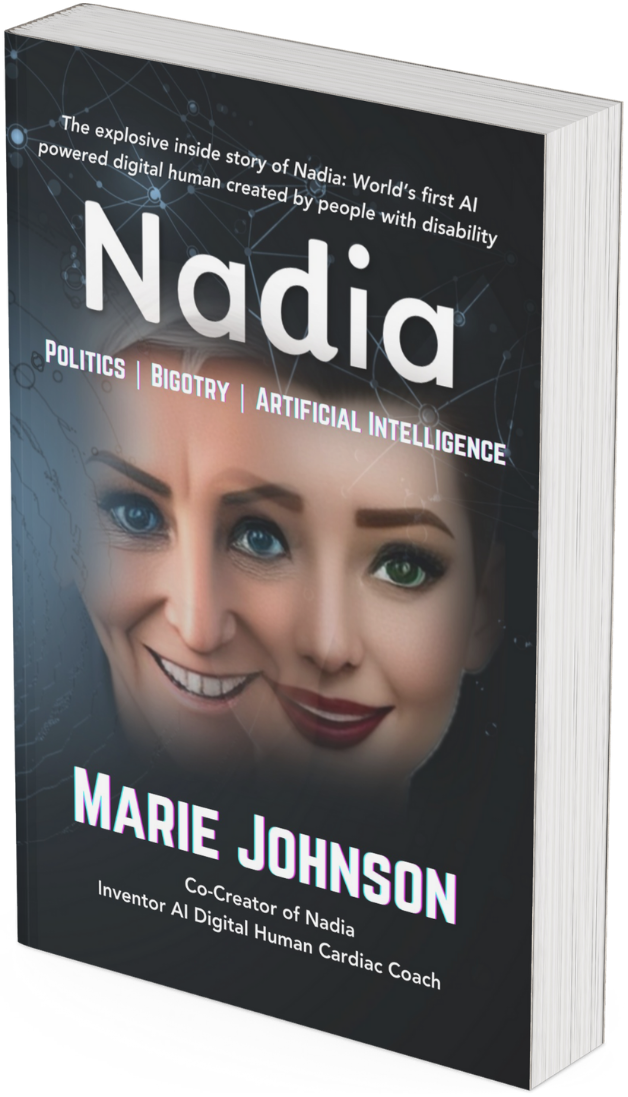Nadia Book Review by Guy Huntington (Canada)
The following is a reproduction of the review of the Nadia book, written by Guy Huntington from Canada, who is a global human and entity identity and learning visionary. Guy’s writings on LinkedIn are a must read for anyone interested in a far more broader and challenging perspective on identity from one of the world’s visionaries in this field. I greatly appreciate Guy’s review, and the time he has taken in reading the book and writing such powerful commentary.
The book review can be read on Guy’s LinkedIn page.
A PDF of the review is available here.
Why Disabled People Will Lead The Planet Rethinking Legal Identity, AI/Bots, Credentials and Learning
Image: From Guy Huntington Article
Updated May 18, 2024
I've spent the last 8 years slowly working my way through rethinking legal identity for humans/AI systems/bots and then leveraged it to rethink learning. Given this, why would I say disabled people are going to lead the way with design, implementation and maintenance of this? Answer - Because they already use all sorts of new tech to understand and communicate with, which is exactly what others will use to leverage their new legal identity, credential and learning tool-kits. If I've caught your interest, read on...
Co-Design
I recently read this book by Marie Johnson from Australia, “Nadia – Politics, Bigotry, Artificial Intelligence”. It described how a national government killed an out of the box, innovative project aimed at leveraging disabled people's expertise to create new interfaces to access disabled programs using co-design. I read it very slowly because it was like me been given a lecture, by a world class expert, in how a government should NOT run a co-design project. It affected me so much, I then redid the entire architectures I'd created (resulting in a 500 page cost centre doc). So, what's co-design?
It's a process where disabled people, and others representing ethnic minorities, are part of the core design, POC (proof of concept), pilot, implementation and maintenance of citizen facing applications. Since many of them have trouble with conventional web-pages and phone interfaces, they are early adopters of new tech like VR (virtual reality), AI (artificial intelligence), AR (augmented reality) and bots (both physical and digital).
This Will Be Heavily Used & Leveraged By The New Architectures
The architectures I've created give each person on the planet the following:
SOLICT (Source of Legal Identity & Credential Truth) database
LSSI (Legal Self-Sovereign Identity) devices including smart cards, digital application, physical wristband biometrically tied to the citizen & chips implanted into them, all used to manage release of different portions of their legal identity and credentials
PIAM (Personal Identity Access Management) AI leveraged service
DLT (Digital Learning Twin)
Which constantly updated an IEP (Individualized Education Plan)
With all their learning data stored in their LDV (Learner Data Vault) database which they control
The architectures also:
Enable citizens to create, register and leverage AI agents/avatars/digital twins
Easily and instantly prove legal identity relationships e.g. parent/child, power of attorney/person, etc.
Easily and instantly authorize use of other people's legal identity and learning data for which they control (e.g. parent/child or person/AI agent, etc.)
All Of Which Are New Tools Which Most People Won't Understand At First
Once they do understand, they need to know how to use the tools to release portions of their legal identity, credentials, DLT, LDV and IEP to third party's. Which is exactly what disabled people have to deal with. Thus, I realized by involving disabled people from the beginning of design processes, their abilities (or disabilities) would be leveraged to create out of the box interfaces all people can use on the planet.
Citizens Will Judge The New Toolkits On How Easy They Are To Use
If citizens don't understand and then easily use the new tools, all the billions of dollars spent creating the architectures, infrastructure, changes to laws and regulations, etc. can be easily screwed. Which is why, when I read Marie's new book, I realized co-design was the keys to the kingdom from a citizen's perspective (as well as from a political leader's perspective).
Disabled People Are Also Critical to National Security
How can I say this? First, skim “National Security – Reduce Risk By Instantly Determining Entity Friend From Foe”. As the Evil Inc.'s and malicious states leverage this tech change curve to daily create new attack vectors against citizens and the new legal identity architecture, it will likely result in fast changes to the legal identity framework. Some of which will result in interface changes to the new tool-kits citizens are using.
Thus, I realized co-design team members must be part of the red team efforts to do 24x7x365 threat analysis against the legal identity architecture. They can quickly determine if a security fix will work as advertised for all citizens using a wide variety of different interfaces. Without this, citizen chaos can quickly occur.
AI Agents & Co-Design
As AI agents explode around the planet, people will instantly want to use them. To see examples of what's coming, skim these articles:
“Personal AI FinTech Agents - Risks, Security And Identity”
“AI/Bots Health Agents, Medical IoT Devices, Risks, Privacy, Security And Legal Identity”
“Marketing In The Age of AI Agents, Bots, Behavioural Tech and Crime”
What will likely be missing is design of the AI agents from a disabled person's perspective. Thus co-design is critical in AI agent design, testing, implementation and maintenance.
We're Entering A Major Paradigm Shift
We're entering a major paradigm shift, where our old ways won't work well anymore. Thus, it requires out of the box thinking for our out of the box times. That's what the new architectures provide. It's also why co-design is mission critical in the design, implementation and maintenance of them. It's time has arrived.
Read more…


